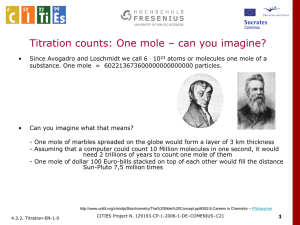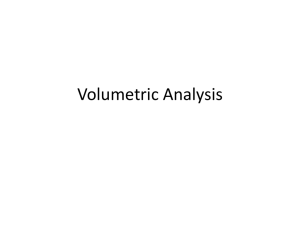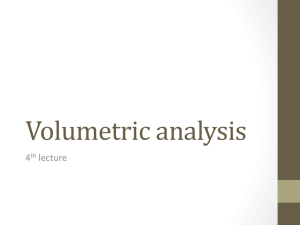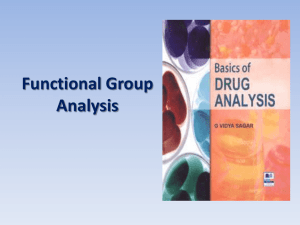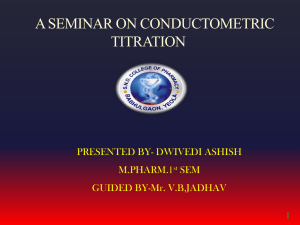Back Titration: Principles, Advantages & Calculations
advertisement
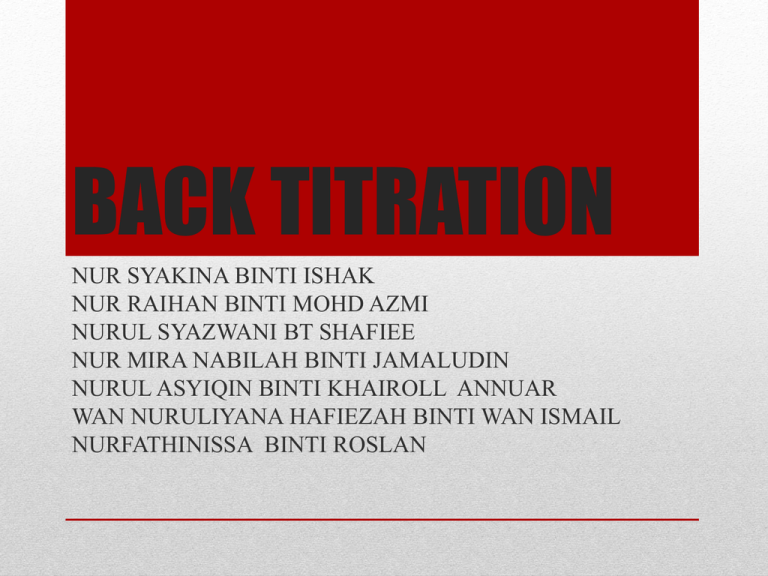
BACK TITRATION NUR SYAKINA BINTI ISHAK NUR RAIHAN BINTI MOHD AZMI NURUL SYAZWANI BT SHAFIEE NUR MIRA NABILAH BINTI JAMALUDIN NURUL ASYIQIN BINTI KHAIROLL ANNUAR WAN NURULIYANA HAFIEZAH BINTI WAN ISMAIL NURFATHINISSA BINTI ROSLAN Alternative technique to direct titration In a simple acid-base titration,a base (reagent) is added in a known quantity – greater than the amount required for acid neutralization. The remaining base is titrated with a standard acid. Acid and base reacts completely. The system has gone from being ACID, past the equivalent point to the BASIC (excess base), and back to the equivalent point again. The final titration to the equivalent point is called BACK TITRATION. Back titration reaction is slow. add NaOH in excess allow the reaction to reach completion titrate the excess NaOH with a standard solution of HCl. The system has gone from being ACID , past the equivalence point to the BASIC side (excess base), and then back to the equivalence point. The final titration to the equivalence point is called a BACK TITRATION. EXAMPLE OF BACK TITRATION The titration of insoluble acid organic acid with NaOH SET UP EXPERIMENT React with the excess volume of reactant which has been left over after completing reaction with the analyte from the normal titration The substance or solution of unknown concentration of excess intermediate reactant is made to react with known volume and concentration of intermediate reactant solution in back titration Properties of back-titration Throughout back titration, the reaction can reach the completion quickly as the excess reactant that react with the NaOH (as example) heated, and is much easier to measure Back titration also an indirect titration procedure the proportion consumed in the reaction of back titration being obtained by difference PURPOSE OF BACK TITRATION Back titration is designed to • 1: The analyte may be in solid resolve some of form the problems • 2: The analyte may contain encountered impurities which may interfere with forward or with direct titration. Consider the case of contaminated chalk. We direct titration. can filter out the impurities before Possible reasons the excess reactant is titrated and for devising thus avoid this situation. back titration technique are : Back titration is designed to resolve some of the problems encountered with forward or direct titration. Possible reasons for devising back titration technique are : • 3: The analyte reacts slowly with titrant in direct or forward titration. The reaction with the intermediate reactant can be speeded up and reaction can be completed say by heating. • 4: Weak acid – weak base reactions can be subjected to back titration for analysis of solution of unknown concentration. Recall that weak acidweak weak titration does not yield a well defined change in pH, which can be detected using an indicator. useful if the endpoint of the reverse titration is easier to identify than the endpoint of the normal titration useful when trying to work out the amount of an acid or base in a nonsoluble solid. ADVANTAGES OF BACK TITRATION Needs skill and practise for effective results Instruments have to be properly calibrated since it will give affected the final result. Reactivity of the elements to be titrated should be well researched since this may affect the end point. Time consuming if done manually DISADVANTAGES OF BACK TITRATION Example 1 150.0 mL of 0.2105 M nitric acid was added in excess to 1.3415 g calcium carbonate. The excess acid was back titrated with 0.1055 M sodium hydroxide. It required 75.5 mL of the base to reach the end point. Calculate the percentage (w/w) of calcium carbonate in the sample. CALCULATION 1.EXTRACT INFORMATION • HNO3 V=150.0 mL M=0.2105 M • CACO3 Mass= 1.3415 g • NAOH M=0.1055 M V=75.5 mL 2. Write balanced equation 2HNO3 + CaCO3 Ca(NO3)2 + CO2 + H2O ------ 1 HNO3 + NaOH NaNO3 + H2O ------- 2 2 mole of HNO3 react with 1 mole of CaCO3 1 mole of HNO3 react with 1 mole of NaOH 3. Calculate no of mole Initial amount HNO3: No of mole of acid = 0.2105 x 150 = 31.575 mole acid. Excess acid No of mole of excess acid = 0.1055 x 75.5 = 7.965 mmole acid mole of acid reacted with CaCO3 = ( 31.575 – 7.965 ) = 23.61 mole acid 4. Mole ratio 2 mole of HNO3 react with 1 mole of CaCO3 Thus,23.61 mole of HNO3 react with ½(23.61) mole of CaCO3 mole of CaCO3 = ½ x mole acid = ½ x 23.61 = 11.805 mole CaCO3. 5. Find mass Gram CaCO3 = mole x molar mass = 11.805 x 10-3 x 100 = 1.1805 g. 6.Find percentage weight CaCO3 % CaCO3 = weight of sample 100 = 1.1805 1.3415 100 = 87.99 % (w/w) A 0.500g sample containing Na2CO3 is analyzed by adding 50.0ml of 0.100M HCL, a slight excess, boiling to remove CO2, and then back-titrating the excess acid with 0.100M NaOH . If 5.6ml NaOH is required for the back titration, what is the percent Na2CO3 in the sample? Molar mass for Na2CO3 = 106 Answer: 47.1% Try this

